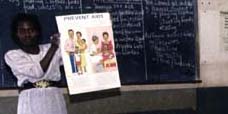2007.08.06: August 6, 2007: Headlines: Museums: Art: COS - Niger: COS - Mali: COS - Burkina Faso: Tuareg: COS - Liberia: Mercury News: As a traveler in North Africa during and after his Peace Corps days, RPCV Tom Seligman met and made friendships with Tuareg that continue to this day - and his respect for them and their culture is deep
Peace Corps Online:
Directory:
Burkina Faso:
Peace Corps Burkina Faso :
Peace Corps Burkina Faso: Newest Stories:
2007.08.06: August 6, 2007: Headlines: Museums: Art: COS - Niger: COS - Mali: COS - Burkina Faso: Tuareg: COS - Liberia: Mercury News: As a traveler in North Africa during and after his Peace Corps days, RPCV Tom Seligman met and made friendships with Tuareg that continue to this day - and his respect for them and their culture is deep
As a traveler in North Africa during and after his Peace Corps days, RPCV Tom Seligman met and made friendships with Tuareg that continue to this day - and his respect for them and their culture is deep
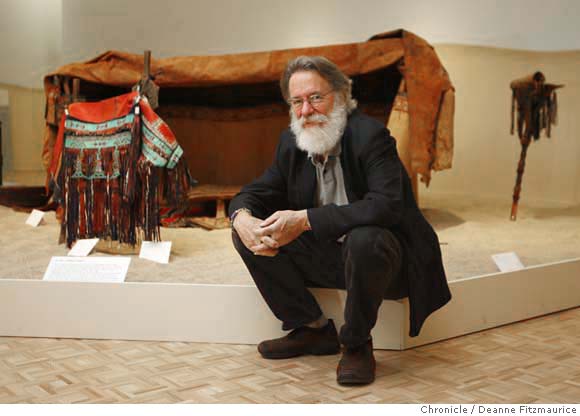
Seligman sees the commonalities between them and those who will see this exhibit. "The Tuareg are just like us, except they live in this really inhospitable desert where it's tough to make a go. We do have different life trajectories, but we have a lot to learn from them," Seligman said. A well-known Tuareg leader, Seligman recounted, talks about being Tuareg as a state of mind, a kind of behavior. "What he is really saying is that if you go through to deeper emotions and think about a more meaningful reality, then we are the same. And we can be with each other and we can be friends."
As a traveler in North Africa during and after his Peace Corps days, RPCV Tom Seligman met and made friendships with Tuareg that continue to this day - and his respect for them and their culture is deep
Art from Africa's desert
By Sara Wykes
Special to the Mercury News
Article Launched: 08/05/2007 01:57:37 AM PDT
Caption: Tom Seligman, Director of Stanford's Cantor Arts Center, poses in front of a Tuareg tent. Chronicle photo by Deanne Fitzmaurice
When Stanford's Cantor Arts Center director Tom Seligman describes his first steps on African soil, as a young Peace Corps volunteer, his words whap the senses.
"We arrived in the middle of the night - 200 volunteers packed in a 707, and it was like somebody took three blankets soaked in water, put them over you and threw you in an oven," he said.
Thankfully, Seligman has not attempted to re-create those first moments, but what he has done, in the Cantor exhibit "Art of Being Tuareg: Sahara Nomads in a Modern World," is to evoke the life of one group of North African people with a sense of place. The exhibit is a carefully pieced quilt of objects, for this is a fully explored tableau of the those people and their lives built from their workday clothes, tools, tents and saddles.
The Tuareg are nomadic tribes who roamed the Sahara, crisscrossing the borders of several North African countries - Niger, Mali, Algeria, Libya and Burkino Faso - long before the borders of those countries were drawn on maps.
The tribes made a name for themselves as sophisticated traders and skilled artisans. Their mystique developed as outsiders marveled at their striking white camels, their highly-developed music and dance and speech, and a natural elegance enhanced further by the indigo-dyed wraps that covered the men's faces except for the eyes.
Seligman's goal was to create an exhibition that would be more than objects hung on walls and displayed in cases.
His approach springs from his willingness to include a multidimensional vision of a people that comes from a first-hand knowledge of the Tuareg.
So, for this exhibit, the Cantor galleries offer a detailed and sensually diverse collection: documentary photographs, a video of a three-day wedding ceremony, Tuareg designs and shapes as adapted by contemporary designers, a powerful set of Tuareg swords and knives. There also is a life-size diorama of a market-day sale, with a blanket filled edge to edge with the silver work admired by many scholars and collectors for its geometric beauty. Alongside are mannequins dressed in actual clothing worn by the artisan couple whose work is displayed.
In the Tuareg tradition, jewelry is an important part of those possessions considered empowering and necessary. In her essay in the exhibit's accompanying book, art historian and co-editor Kristyne Loughran describes "the very clear ideas about how they should look and present themselves." The Tuareg move slowly, she said, and as they do, their garments "sway gently around them." The jewelry, she adds, must also move and shine to accomplish its social purpose.
The exhibit includes stand-alone displays of jewelry - amulets in particular - dating back centuries. Its presence as part of women's and men's adornments is as essential as is another crafted Tuareg item, their nomadic homes built of mats or goatskin.
Along one gallery wall, for instance, is a tent pitched as if ready for its residents to return. The tent has a long, narrow opening that offers its dark interior as cool comfort.
The structure is supported by carved tent poles. Woven reed mats act as windscreens that are easily moved if the wind changes directions. Tucked around the tent are leather bags and cushions with geometric patterns that dazzle in their intricacy and brilliant colors.
For three decades, historians, anthropologist and other collaborators in America, Europe and Africa have studied the Tuareg, gathering their history and tracking their evolution as citizens of a modernized and globalized world.
The Cantor joined with the UCLA Fowler Museum of Cultural History, in addition to colleagues at other museums, to design the exhibit and produce a book that is much more than an exhibition catalog. Filled with photographs, maps and essays, the book is the first scholarly work published in English to focus on the Tuareg.
As a traveler in North Africa during and after his Peace Corps days, Seligman met and made friendships with Tuareg that continue to this day - and his respect for them and their culture is deep.
And he sees the commonalities between them and those who will see this exhibit. "The Tuareg are just like us, except they live in this really inhospitable desert where it's tough to make a go. We do have different life trajectories, but we have a lot to learn from them," Seligman said.
A well-known Tuareg leader, Seligman recounted, talks about being Tuareg as a state of mind, a kind of behavior. "What he is really saying is that if you go through to deeper emotions and think about a more meaningful reality, then we are the same. And we can be with each other and we can be friends."
The show runs through Sept. 2. Art of Being Tuareg:
Sahara Nomads in a Modern World
By Sara Wykes
Where: Cantor Arts Center, Lomita Drive and Museum Way, Stanford
When: 11 a.m.-5 p.m. Wednesdays through Sundays; open until 8 p.m. Thursdays
Tickets: Admission is free.
Information: (650) 725-0464 or http://museum.stanford.edu.
Silver working demonstrations
By Sara Wykes
Tuareg brothers Salah and Ousman Saidi will be at the Cantor Center to demonstrate silver working. They will be demonstrate their techniques in the exhibition gallery and, when using a torch, in the courtyard.
Where: Cantor Arts Center, Lomita Drive and Museum Way, Stanford.
When: 11 a.m.-5 p.m. (except for breaks), Aug. 16-19; Aug. 22-26 and Aug. 29-Sept. 1.
Tickets: Admission is free.
Links to Related Topics (Tags):
Headlines: August, 2007; Museums; Art; Peace Corps Niger; Directory of Niger RPCVs; Messages and Announcements for Niger RPCVs; Peace Corps Mali; Directory of Mali RPCVs; Messages and Announcements for Mali RPCVs; Peace Corps Burkina Faso; Directory of Burkina Faso RPCVs; Messages and Announcements for Burkina Faso RPCVs; Peace Corps Liberia; Directory of Liberia RPCVs; Messages and Announcements for Liberia RPCVs
When this story was posted in September 2007, this was on the front page of PCOL:





Peace Corps Online The Independent News Forum serving Returned Peace Corps Volunteers
 | Senator Dodd's Peace Corps Hearings
Read PCOL's executive summary of Senator Chris Dodd's hearings on July 25 on the Peace Corps Volunteer Empowerment Act and why Peace Corps Director Ron Tschetter does not believe the bill would contribute to an improved Peace Corps while four other RPCV witnesses do. Highlights of the hearings included Dodd's questioning of Tschetter on political meetings at Peace Corps Headquarters and the Inspector General's testimony on the re-opening of the Walter Poirier III investigation. |
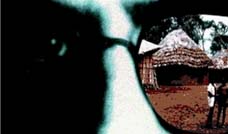 | Paul Theroux: Peace Corps Writer
Paul Theroux began by writing about the life he knew in Africa as a Peace Corps Volunteer. His first first three novels are set in Africa and two of his later novels recast his Peace Corps tour as fiction. Read about how Theroux involved himself with rebel politicians, was expelled from Malawi, and how the Peace Corps tried to ruin him financially in John Coyne's analysis and appreciation of one of the greatest American writers of his generation (who also happens to be an RPCV). |
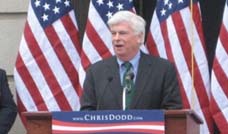 | Dodd issues call for National Service
Standing on the steps of the Nashua City Hall where JFK kicked off his campaign in 1960, Presidential Candidate Chris Dodd issued a call for National Service. "Like thousands of others, I heard President Kennedy's words and a short time later joined the Peace Corps." Dodd said his goal is to see 40 million people volunteering in some form or another by 2020. "We have an appetite for service. We like to be asked to roll up our sleeves and make a contribution," he said. "We haven't been asked in a long time." |
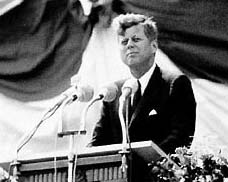 | Public diplomacy rests on sound public policy
When President Kennedy spoke of "a long twilight struggle," and challenged the country to "ask not," he signaled that the Cold War was the challenge and framework defining US foreign policy. The current challenge is not a struggle against a totalitarian foe. It is not a battle against an enemy called "Islamofascism." From these false assumptions flow false choices, including the false choice between law enforcement and war. Instead, law enforcement and military force both must be essential instruments, along with diplomacy, including public diplomacy. But public diplomacy rests on policy, and to begin with, the policy must be sound. Read more. |
 | Ambassador revokes clearance for PC Director
A post made on PCOL from volunteers in Tanzania alleges that Ambassador Retzer has acted improperly in revoking the country clearance of Country Director Christine Djondo. A statement from Peace Corps' Press Office says that the Peace Corps strongly disagrees with the ambassador’s decision. On June 8 the White House announced that Retzer is being replaced as Ambassador. Latest: Senator Dodd has placed a hold on Mark Green's nomination to be Ambassador to Tanzania. |
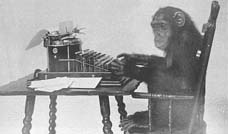 | Peace Corps Funnies
A PCV writing home? Our editor hard at work? Take a look at our Peace Corps Funnies and Peace Corps Cartoons and see why Peace Corps Volunteers say that sometimes a touch of levity can be one of the best ways of dealing with frustrations in the field. Read what RPCVs say about the lighter side of life in the Peace Corps and see why irreverent observations can often contain more than a grain of truth. We'll supply the photos. You supply the captions. |
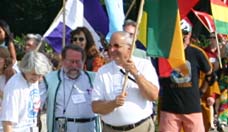 | PCOL serves half million
PCOL's readership for April exceeded 525,000 visitors - a 50% increase over last year. This year also saw the advent of a new web site: Peace Corps News that together with the Peace Corps Library and History of the Peace Corps serve 17,000 RPCVs, Staff, and Friends of the Peace Corps every day. Thanks for making PCOL your source of news for the Peace Corps community. Read more. |
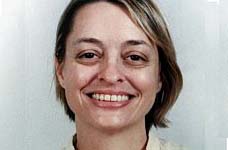 | Suspect confesses in murder of PCV
Search parties in the Philippines discovered the body of Peace Corps Volunteer Julia Campbell near Barangay Batad, Banaue town on April 17. Director Tschetter expressed his sorrow at learning the news. “Julia was a proud member of the Peace Corps family, and she contributed greatly to the lives of Filipino citizens in Donsol, Sorsogon, where she served,” he said. Latest: Suspect Juan Duntugan admits to killing Campbell. Leave your thoughts and condolences . |
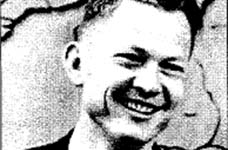 | Warren Wiggins: Architect of the Peace Corps
Warren Wiggins, who died at 84 on April 13, became one of the architects of the Peace Corps in 1961 when his paper, "A Towering Task," landed in the lap of Sargent Shriver, just as Shriver was trying to figure out how to turn the Peace Corps into a working federal department. Shriver was electrified by the treatise, which urged the agency to act boldly. Read Mr. Wiggins' obituary and biography, take an opportunity to read the original document that shaped the Peace Corps' mission, and read John Coyne's special issue commemorating "A Towering Task." |
 | He served with honor
One year ago, Staff Sgt. Robert J. Paul (RPCV Kenya) carried on an ongoing dialog on this website on the military and the peace corps and his role as a member of a Civil Affairs Team in Iraq and Afghanistan. We have just received a report that Sargeant Paul has been killed by a car bomb in Kabul. Words cannot express our feeling of loss for this tremendous injury to the entire RPCV community. Most of us didn't know him personally but we knew him from his words. Our thoughts go out to his family and friends. He was one of ours and he served with honor. |
Read the stories and leave your comments.

Some postings on Peace Corps Online are provided to the individual members of this group without permission of the copyright owner for the non-profit purposes of criticism, comment, education, scholarship, and research under the "Fair Use" provisions of U.S. Government copyright laws and they may not be distributed further without permission of the copyright owner. Peace Corps Online does not vouch for the accuracy of the content of the postings, which is the sole responsibility of the copyright holder.
Story Source: Mercury News
This story has been posted in the following forums: : Headlines; Museums; Art; COS - Niger; COS - Mali; COS - Burkina Faso; Tuareg; COS - Liberia
PCOL38506
21


















